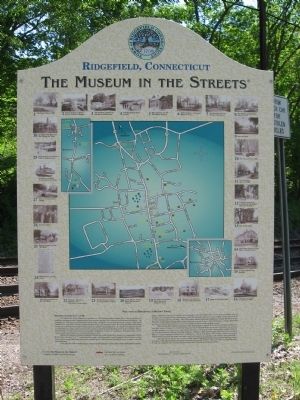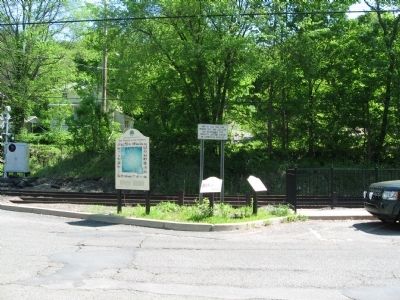Ridgefield in Fairfield County, Connecticut — The American Northeast (New England)
Ridgefield, Connecticut
The Museum in the Streets®
Welcome to Ridgefield's History Trail!
Ridgefield, Connecticut – 1708
The Fundamental Orders adopted by Connecticut in 1639 directed would-be settlers, able to support a minister, to establish a settlement, build a Congregational Church and farm the land. This is exactly what was done in Ridgefield. On September 30, 1708 a group of inhabitants from Norwalk and Milford, Connecticut purchased a parcel of land called Caudatowa, or "high land", from the resident Ramapo tribe for one hundred pounds. This parcel and additional acreage purchased from the tribe became the town the original "proprietors" named Ridgefield. The original 24 proprietors received 7 ˝-acre home lots, with a 25th reserved for the minister, located up and down Main Street from a Common where a Meeting House was built. Small, close knit and agrarian Ridgefield lived under the watchful eye of Congregational minister Thomas Hauley, who also served as schoolmaster and town clerk.
During the American Revolution Ridgefield was the site of the Connecticut's largest land engagement with the British Army. On April 27, 1777 American patriots under General Benedict Arnold engaged the British forces on their retreat back to Long Island Sound after having sacked Danbury and burned the Continental Army's supplies which had been stored there.
In the early the 1800's commerce grew in town with the building of various mills and the establishment of hatters, tailors, carpenters, weavers, silversmiths and shoemakers. The 19th century also saw the birth of industry with the Resseguie and Olmstead carriage "manufactory" called the Big Shop, which was located on Main Street at the site of the current Congregational Church building. Other 19th century manufacturers made candlesticks, furniture and shirts. As they flourished, owners began to enlarge their homes or build new ones and the face of Main Street began to change. Main Street was improved and the land of the town common was divided up among abutting property owners.
After the Civil War a number of prominent new Yorkers eager to summer away from the city began building mansion-sized summer residences on South Main Street and on East and High Ridge. By the end of the century the town also boasted a number of very large estates whose owners and servants arrived at the town's depot on trains coming into the village from the Branchville-Danbury. From there, chauffeurs took them to their country homes. At this time a significant number of Italian immigrants immigrated to Ridgefield to work on these estates. Most of these families remained in Ridgefield throughout the 20th century and made a significant impact on the community both culturally and economically.
Today
the railroad line, the town common and the original Congregational Church are gone. The Big Shop remains, as do many of the large homes that have graced Main Street since the late 1800's. In 1966 much of the area originally settled in 1708 was designated a state and local Historic District and in 1984 a National Historic District.
Erected by The Museum in the Streets®. (Marker Number Map.)
Topics and series. This historical marker is listed in this topic list: Settlements & Settlers. In addition, it is included in the The Museum in the Streets®: Ridgefield, Connecticut series list. A significant historical month for this entry is April 1910.
Location. 41° 16.042′ N, 73° 26.464′ W. Marker is in Ridgefield, Connecticut, in Fairfield County. Marker is at the intersection of Ethan Allen Highway (U.S. 7) and Branchville Road (Connecticut Route 102), on the right when traveling north on Ethan Allen Highway. Located at the entrance to the Metro-North railroad parking lot. Touch for map. Marker is at or near this postal address: 48 W Branchville Rd, Ridgefield CT 06877, United States of America. Touch for directions.
Other nearby markers. At least 8 other markers are within 3 miles of this marker, measured as the crow flies. Quarries, Abrasives and the "Fresh Air" Kids (here, next to this marker); Branchville – A Center of Italian–American Life (here, next to this marker); Old Hundred (approx. 0.7 miles away); Weir Farm National Historic Site (approx. 1.1 miles away); Ensign James Benedict House (approx. 2.7 miles away); Ye Burying Yard (approx. 2.7 miles away); State Police and the Benjamin Franklin School (approx. 2.9 miles away); Keeler Tavern (approx. 2.9 miles away). Touch for a list and map of all markers in Ridgefield.
Credits. This page was last revised on August 16, 2023. It was originally submitted on June 18, 2010, by Michael Herrick of Southbury, Connecticut. This page has been viewed 819 times since then and 27 times this year. Photos: 1, 2. submitted on June 18, 2010, by Michael Herrick of Southbury, Connecticut.

